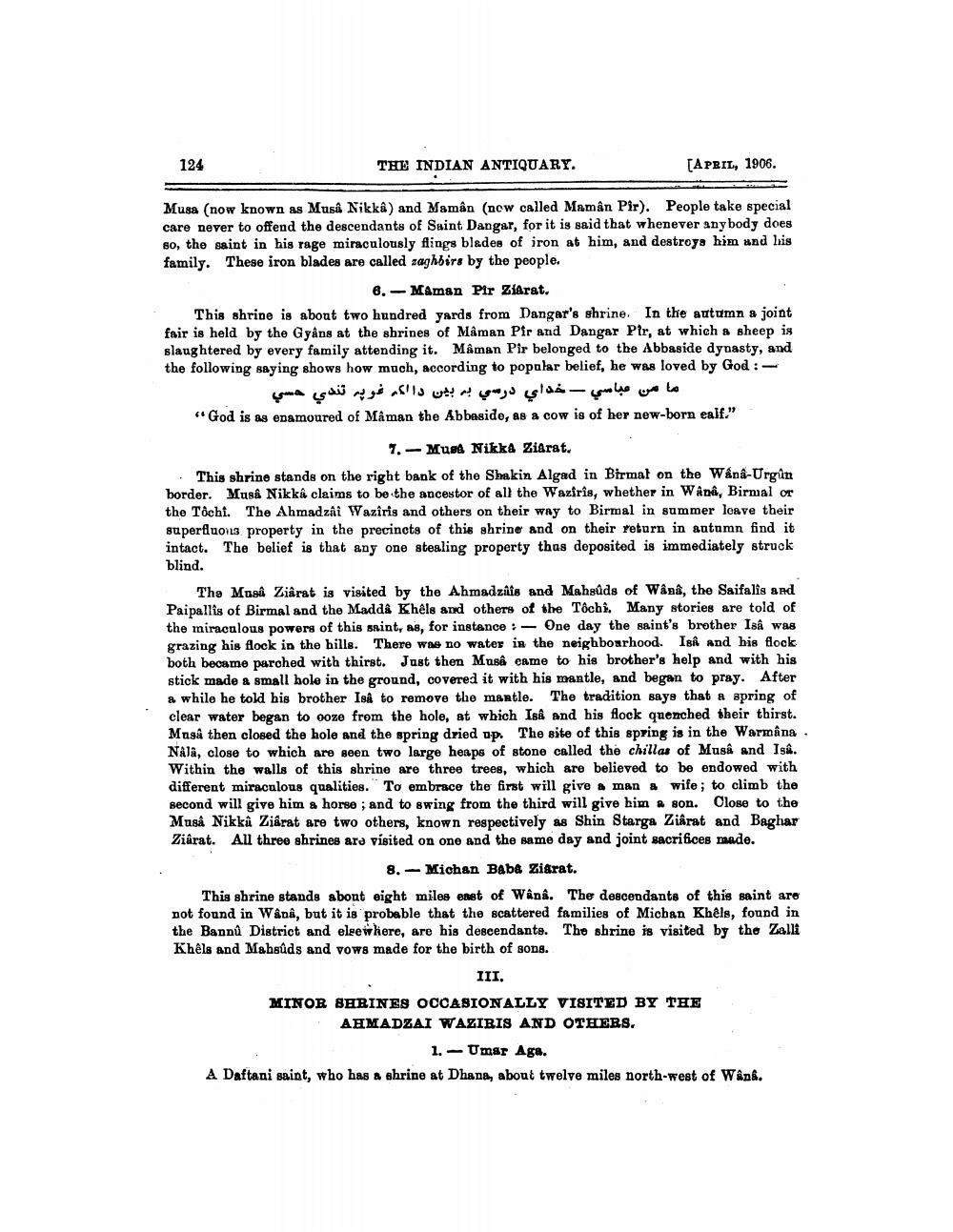________________
124
THE INDIAN ANTIQUARY.
[APRIL, 1906.
Musa (now known as Musâ Nikkâ) and Mamân (new called Mamân Pir). People take special care never to offend the descendants of Saint Dangar, for it is said that whenever anybody does so, the saint in his rage miraculously flings blades of iron at him, and destroys him and his family. These iron blades are called zaghbirs by the people.
6.Maman Pir Ziarat.
This shrine is about two hundred yards from Dangar's shrine. In the autumn a joint fair is held by the Gyâns at the shrines of Mâman Pir and Dangar Pir, at which a sheep is slaughtered by every family attending it. Mâman Pir belonged to the Abbaside dynasty, and the following saying shows how much, according to popular belief, he was loved by God:
ما من عباسي – خداي درسي به بين دا کم غوپه تندي حسي
"God is as enamoured of Mâman the Abbaside, as a cow is of her new-born ealf."
7. Must Nikka Ziarat.
This shrine stands on the right bank of the Shakin Algad in Birmat on the Wânâ-Urgûn border. Musâ Nikkâ claims to be the ancestor of all the Waziris, whether in Wânâ, Birmal or the Tôchi. The Ahmadzai Waziris and others on their way to Birmal in summer leave their superfluous property in the precincts of this shrine and on their return in autumn find it intact. The belief is that any one stealing property thas deposited is immediately struck
blind.
The Masi Ziarat is visited by the Ahmadzils and Mahsûds of Wânâ, the Saifalis and Paipallis of Birmal and the Maddâ Khêls and others of the Tôchi. Many stories are told of the miraculous powers of this saint, as, for instance :- One day the saint's brother Isâ was grazing his flock in the hills. There was no water in the neighbourhood. Isa and his flock both became parched with thirst. Just then Musâ came to his brother's help and with his stick made a small hole in the ground, covered it with his mantle, and began to pray. After a while he told his brother Isâ to remove the mantle. The tradition says that a spring of clear water began to ooze from the hole, at which Isâ and his flock quenched their thirst. Musâ then closed the hole and the spring dried up. The site of this spring is in the Warmâna. Nâlâ, close to which are seen two large heaps of stone called the chillas of Musâ and Isa. Within the walls of this shrine are three trees, which are believed to be endowed with different miraculous qualities. To embrace the first will give a man a wife; to climb the second will give him a horse; and to swing from the third will give him a son. Close to the Musâ Nikkû Ziarat are two others, known respectively as Shin Starga Ziarat and Baghar Ziârat. All three shrines are visited on one and the same day and joint sacrifices made.
8.
Michan Baba Ziarat.
This shrine stands about eight miles east of Wânâ. The descendants of this saint are not found in Wânâ, but it is probable that the scattered families of Michan Khêls, found in the Bannů District and elsewhere, are his descendants. The shrine is visited by the Zalli Khêls and Mahsûds and vows made for the birth of sons.
III.
MINOR SHRINES OCCASIONALLY VISITED BY THE AHMADZAI WAZIRIS AND OTHERS.
1. Umar Aga.
A Daftani saint, who has a shrine at Dhana, about twelve miles north-west of Wânâ.




